Online collection at https://z.umn.edu/forgotpop22 – 40% off with discount code MN89230, valid through July 15, 2022.
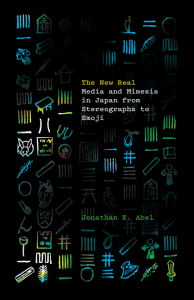
The New Real: Media and Mimesis in Japan from Stereographs to Emoji
Year: 2023
Author: Jonathan Abel
A synthetic history of new media reception in modern and contemporary Japan, The New Real positions mimesis at the heart of the media concept. Considering both mimicry and representation as the core functions of mediation and remediation, it offers a new model for media studies while explaining the deep and ongoing imbrication of Japan in the history of new media.
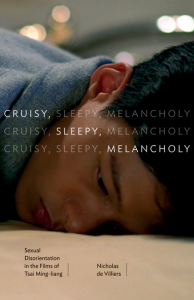 Cruisy, Sleepy, Melancholy: Sexual Disorientation in the Films of Tsai Ming-liang
Cruisy, Sleepy, Melancholy: Sexual Disorientation in the Films of Tsai Ming-liang
Year: 2022
Author: Nicholas de Villiers
A critical figure in queer Sinophone cinema, Tsai Ming-liang is a major force in Taiwan cinema and global moving image art. Cruisy, Sleepy, Melancholy offers a fascinating, systematic method for analyzing the queerness of Tsai’s films, drawing on extensive interviews with the director while also offering a complete reappraisal of Tsai’s body of work.
 Cinema Illuminating Reality: Media Philosophy through Buddhism
Cinema Illuminating Reality: Media Philosophy through Buddhism
Year: 2022
Author: Victor Fan
Victor Fan’s dialogue between Buddhism and Euro-American philosophy is the first of its kind in film and media studies. From Chinese queer cinema to a reexamination of Japanese master Ozu’s work and its historical reception to Christian Petzold’s 2018 existential thriller Transit, Cinema Illuminating Reality forges a remarkable path between Buddhist studies and cinema studies, casting vital new light on both of these important subjects.
Contents:
Dependent Originations
Note on Languages
Introduction: Cinema: A Technicity-Consciousness
1. Meontology
2. The Karma-Image
3. The Insight-Image
4. Cinema Ecology
5. In-Aesthetics
Conclusion: Cinema and Nonviolence
Multilingual Glossary of Buddhist Terms, Names, and Titles
Notes
Filmography
Index
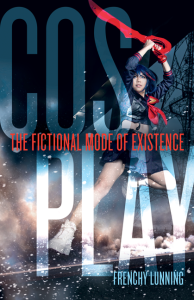 Cosplay: The Fictional Mode of Existence
Cosplay: The Fictional Mode of Existence
Year: 2022
Author: Frenchy Lunning
Cosplay is a unique and necessary examination of identity, performance, play, and otaku fandom and culture in relation to contemporary theories. Through a culmination of years of personal research on cosplay, author Frenchy Lunning offers an intimate, sensational tour through cosplay’s past and present, as well as its global lure.
Contents:
Acknowledgments
Introduction: The Cosplay Experience
1. Cosplay: A Social History of Mass Culture and Identity
2. The Lure of the Mask: Identity, Expression, and Embodiment
3. Overcoming Abjection: From Ambiguity to Becoming
4. In the Theater of the Cosplayer: Improvisations, Innovations, and Masquerade
5. Fandom and the Fictional Mode of Existence
Notes
Index
 Future History of Contemporary Chinese Art
Future History of Contemporary Chinese Art
Year: 2021
Author: Peggy Wang
During the 1980s and 1990s, a group of Chinese artists (Zhang Xiaogang, Wang Guangyi, Sui Jianguo, Zhang Peili, and Lin Tianmiao) ascended to new heights of international renown. Peggy Wang offers a corrective to previous appraisals, demonstrating how their works address fundamental questions about the forms, meanings, and possibilities of art.
Contents:
Note on Translations and Names
Acknowledgments
Introduction: Actors in the World
1. Spaces of Self-Recognition
2. Zhang Xiaogang: Bloodline and Belonging
3. Wang Guangyi: Pop and the People
4. Sui Jianguo: The Matter of Endurance
5. Zhang Peili: Dangers of Definition
6. Lin Tianmiao: Threads of Resistance
Conclusion: Art in the World
Notes
Bibliography
Index
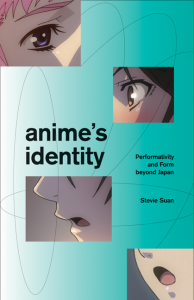 Anime’s Identity: Performativity and Form beyond Japan
Anime’s Identity: Performativity and Form beyond Japan
Year: 2021
Author: Stevie Suan
In Anime’s Identity, Stevie Suan examines how anime’s recognizable media-form—no matter where it is produced—reflects the problematics of globalization. Anime’s Identity deftly merges theories from media studies and performance studies, introducing innovative formal concepts that connect anime to questions of dislocation on a global scale, creating a transformative new lens for analyzing popular media.
Contents:
Introduction: Anime’s Performance of Identity
1. Anime’s Local–Global Tensions
2. Anime’s Dispersed Production
3. Anime’s Media Heterotopia
4. Anime’s Citationality
5. Anime’s Creativity
6. Anime’s Actors
7. Anime’s (Anti)Individualism
8. Anime’s Dislocation
Conclusion: Anime’s World
Acknowledgments
Notes
Index
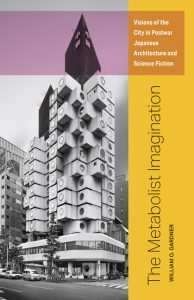 Metabolist Imagination: Visions of the City in Postwar Japanese Architecture and Science Fiction
Metabolist Imagination: Visions of the City in Postwar Japanese Architecture and Science Fiction
Year: 2020
Author: William Gardner
William O. Gardner explores the unique Metabolism movement, which allied with science fiction authors to foresee the global cities that would emerge in the postwar era. These studies are underscored by Gardner’s insightful approach—treating architecture as a form of speculative fiction while positioning science fiction as an intervention into urban design—making it a necessary read for today’s visionaries.
Contents:
Acknowledgments
Introduction
1. City Visions: Metabolism and Science Fiction
2. Ruined Cities: Isozaki Arata and Komatsu Sakyô
3. Planetary Cities: Komatsu Sakyô’s Disaster Fiction
4. Future City: The 1970 Osaka Expo
5. Liquid Cities: The Technopolis from Expo to Cyberpunk
6. Metabolist Echoes: Akira, Patlabor, and Yanobe Kenji
Notes
Selected Filmography
Bibliography
Index
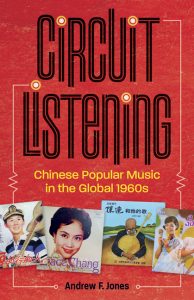 Circuit Listening: Chinese Poplar Music in the Global 1960s
Circuit Listening: Chinese Poplar Music in the Global 1960s
Year: 2020
Author: Andrew Jones
What did Mao’s China have to do with the music of youth revolt in the 1960s, and how did the Beatles and Bob Dylan sound on the front lines of the Cold War in Asia? Andrew F. Jones listens in on the 1960s beyond the West, suggesting how transistor technology, decolonization, and the Green Revolution transformed the sound of music globally.
Contents:
Acknowledgments
Introduction. The East is Red: Towards a Sonic History of the 1960s
1. Circuit Listening at the Dawn of the Chinese 1960s
2. Quotation Songs: Media Infrastructure and Pop Song Form in Mao’s China
3. Fugitive Sounds of the Taiwanese Musical Cinema
4. Pirates of the China Seas: Vinyl Records and the Military Circuit
5. Folk Circuits: Rediscovering Chen Da
6. Teresa Teng and the Network Trace
Appendix: “Listening to Songs in the Streets of Taipei”
Hsu Tsang-Houei
Notes
Index
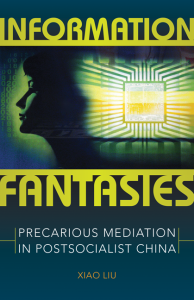 Information Fantasies: Precarious Meditation in Postsocialist China
Information Fantasies: Precarious Meditation in Postsocialist China
Year: 2019
Author: Xiao Liu
Information Fantasies offers a revisionist account of the emergence of the “information society,” arguing that it was developed out of a set of techno-cultural imaginations and practices that arrived alongside postsocialism. Ranging over forgotten science fiction, unjustly neglected films, corporeal practices such as qigong, scientific journals, advertising, and cybernetic theories, it constructs an alternate genealogy of digital and information imaginaries.
Contents:
Introduction: “Information Pot” and Postsocialist Politics of Mediation
1. Extrasensory Powers, Magic Waves, and Information Explosion: Imagining the Digital
2. The Curious Case of a Robot Doctor: Rethinking Labor, Expert Systems, and the Interface
3. The “Ultrastable System” and the New Cinema
4. Affective Form: Advertising, Information Aesthetics, and Experimental Writing in the Market Economy
5. Liminal Mediation and the Cinema Redefined
Epilogue: The Virtual Past(s) of the Future(s)
Acknowledgments
Notes
Index
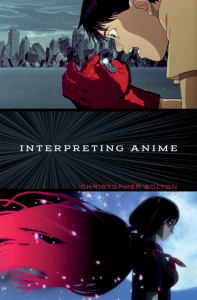 Interpreting Anime
Interpreting Anime
Year: 2018
Author: Christopher Bolton
Interpreting Anime is a thoughtful introduction to Japanese animation for anyone eager to see why this genre has remained a vital, adaptable art form for decades. It reveals what makes anime unique as a medium: how it engages profound social and political realities while also drawing attention to the challenges of representing reality in animation’s imaginative and compelling visual forms.
Contents:
A Note on the Text
Introduction. Read or Die: Reading Anime
1. From Origin to Oblivion: Akira as Anime and Manga
2. The Mecha’s Blind Spot: Cinematic and Electronic in Patlabor 2
3. Puppet Voices, Cyborg Souls: Ghost in the Shell and Classical Japanese Theater
4. The Forgetful Phallus and the Otaku’s Third Eye: 3×3 Eyes and Anime’s Audience
5. Anime in Drag: Stage Performance and Staged Performance in Millennium Actress
6. The Quick and the Undead: Blood: The Last Vampire and Television Anime
7. It’s Art, but Is It Anime? Howl’s Moving Castle and the Novel
Conclusion: Summer Wars
Chronology
Acknowledgments
Notes
Moving Image Sources
Bibliography
Index
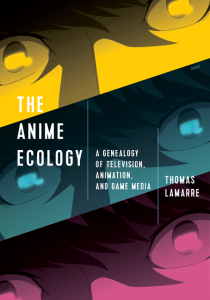 The Anime Ecology: A Genealogy of Television, Animation, and Game Media
The Anime Ecology: A Genealogy of Television, Animation, and Game Media
Year: 2018
Author: Thomas Lamarre
Thomas Lamarre uses the overlaps between television, anime, and new media—from console games and video to iOS games and streaming—to show how animation helps us think through television in the contemporary moment. Thoughtful, thorough illustrations plus exhaustive research and an impressive scope make this an essential reference book, a valuable resource for scholars, and a foundational textbook for students.
Contents:
Introduction: Television Animation and Infrastructure Ecology
Part I. The Screen–Brain Apparatus
1. Population Seizure
2. Neurosciences and Television
3. This Stuff Called Blink
4. A Thousand Tiny Blackouts
Part II. A Little Social Media History of Television
5. Media Genealogy and Transmedia Ecology
6. A Little History of Japanese Television
7. Television and New Media
8. Sociality or Something Like It
9. Platformativity and Ontopower
Part III. Infrastructure Complexes
10. The Family Broadcast Complex
11. The Home Theater Complex
12. The Game Play Complex
13. The Portable Interface Complex
Conclusion: Signaletic Animism
Notes
Bibliography
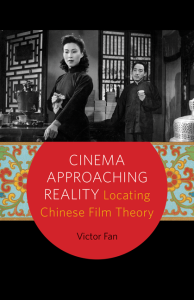 Cinema Approaching Reality: Locating Chinese Film Theory
Cinema Approaching Reality: Locating Chinese Film Theory
Year: 2015
Author: Victor Fan
In Cinema Approaching Reality, Victor Fan brings together, for the first time, Chinese and Euro-American film theories and theorists to engage in critical debates about film in Shanghai and Hong Kong from the 1920s through the 1940s. The result is an eye-opening exploration of the potentialities in approaching cinema anew, especially in the photographic materiality following its digital turn.
Contents:
Acknowledgments
Note on Transliteration
Introduction
1. Approaching Reality: Chinese Ontology and the Potentiality of Time
2. Cinema of Thought: Directed Consciousness in Chinese Marxist Film Theory
3. Soft Film Theory: Life in All Its Presence and Concreteness
4. Fey Mou: The Presence of an Absence
5. Cinema of Ideation, Cinema of Play: The Early Cantonese Sound Film
Conclusion
Notes
Filmography
Index
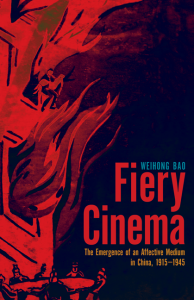 Fiery Cinema: The Emergence of an Affective Medium in China, 1915-1945
Fiery Cinema: The Emergence of an Affective Medium in China, 1915-1945
Year: 2015
Author: Weihong Bao
In Fiery Cinema, Weihong Bao traces the permutations of cinema as an affective medium in China from the early through the mid-twentieth century, exploring its role in aesthetics, politics, and social institutions.
Contents:
Introduction
Part I. Resonance
1. Fiery Action: Toward an Aesthetics of New Heroism
2. A Culture of Resonance: Hypnotism, Wireless Cinema, and the Invention of Intermedial Spectatorship
Part II. Transparency
3. Dances of Fire: Mediating Affective Immediacy
4. Transparent Shanghai: Cinema, Architecture, and a Left-Wing Culture of Glass
Part III. Agitation
5. “A Vibrating Art in the Air”: The Infinite Cinema and the Media Ensemble of Propaganda
6. Baptism by Fire: Atmospheric War, Agitation, and a Tale of Three Cities
Acknowledgments
Notes
Filmography
Index
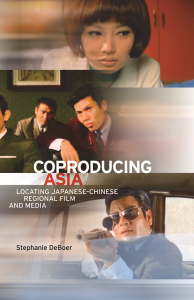 Coproducing Asia: Locating Japanese-Chinese Regional Film and Media
Coproducing Asia: Locating Japanese-Chinese Regional Film and Media
Year: 2014
Author: Stephanie DeBoer
Based on rare archival research as well as interviews with producers, Coproducing Asia provides compelling frames for understanding the significance of film and media coproduction in East Asia. Stephanie DeBoer guides readers through a rich genealogy of regional film and media coproduction, introducing innovative methods for their examination across decades, locations, and scales of production in East Asia and beyond.
Contents:
Introduction: Coproduction and the New East Asia
1. The Bright Asian Market Place: Regional Specters of Connection and Desire
2. Collaboration Decentered: Technology Transfer and the Hong Kong Copy
3. Sino–Japanese Techno-Friendship: Location, Presence, and Memory’s Displacement
4. Tokyo on the Move: Omnibus Asia, Media Capital, and the Limits of the Link
5. Working through China: Scale, Place, and New Asian Coproduction
Conclusion. Scaling the Frame: Genealogies of Coproduction and the Asian Frontier
Acknowledgments
Notes
Filmography
Index
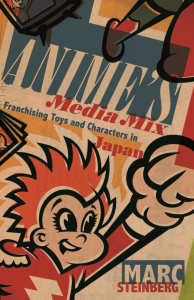 Anime’s Media Mix: Franchising Toys and Characters in Japan
Anime’s Media Mix: Franchising Toys and Characters in Japan
Year: 2012
Author: Marc Steinberg
In Anime’s Media Mix, Marc Steinberg convincingly shows that anime is far more than a style of Japanese animation. Engaging with film, animation, and media studies, as well as analyses of consumer culture and theories of capitalism, Steinberg offers the first sustained study of the Japanese mode of convergence that informs global media practices to this day.
Contents:
Introduction: Rethinking Convergence in Japan
Part I. Anime Transformations: Tetsuwan Atomu
1. Limiting Movement, Inventing Anime
2. Candies, Premiums, and Character Merchandizing: The Meiji-Atomu Marketing Campaign
3. Material Communication and the Mass Media Toy
Part II. Media Mixes and Character Consumption: Kadokawa Books
4. Media Mixes, Media Transformations
5. Character, World, Consumption
Acknowledgments
Notes
Bibliography
Index
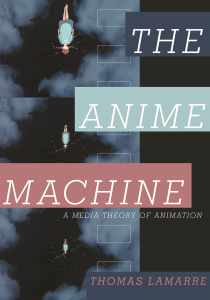 The Anime Machine: A Media Theory of Animation
The Anime Machine: A Media Theory of Animation
Year: 2009
Author: Thomas Lamarre
Despite the longevity of animation and its significance within the history of cinema, film theorists have focused on live-action motion pictures and largely ignored hand-drawn and computer-generated movies. Thomas Lamarre contends that animation demands sustained engagement, and in The Anime Machine he lays the foundation for a new critical theory for reading Japanese animation, showing how anime fundamentally differs from other visual media.
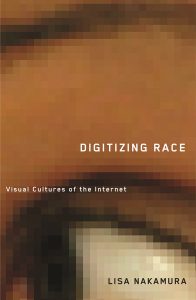 Digitizing Race: Visual Cultures of the Internet
Digitizing Race: Visual Cultures of the Internet
Year: 2007
Author: Lisa Nakamura
Lisa Nakamura, a leading scholar in the examination of race in digital media, looks at the emergence of race-, ethnic-, and gender-identified visual cultures through popular yet rarely evaluated uses of the Internet. While popular media depict people of color and women as passive audiences, Nakamura argues that they use the Internet to vigorously articulate their own types of virtual community, avatar bodies, and racial politics.